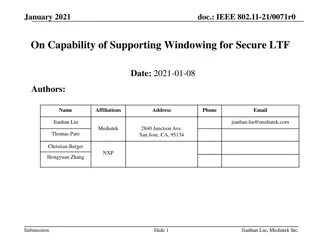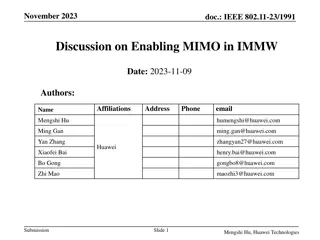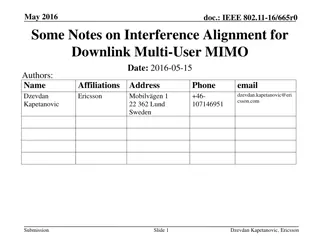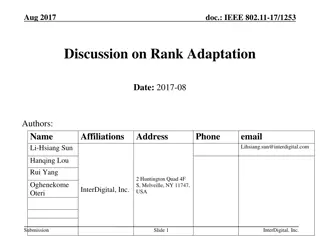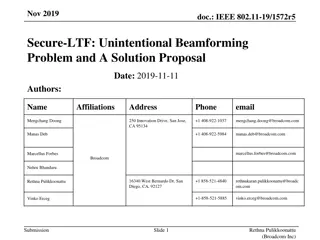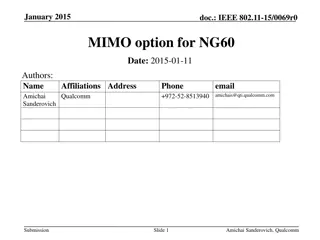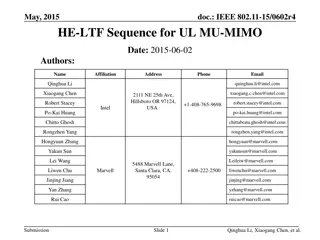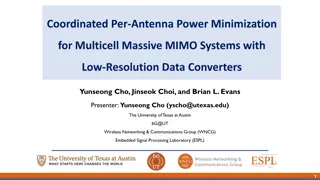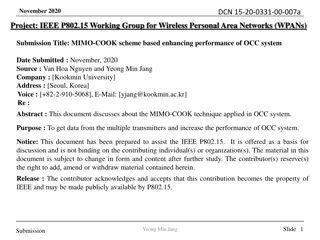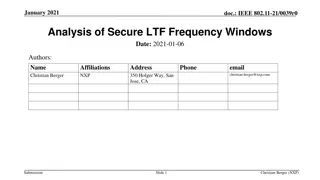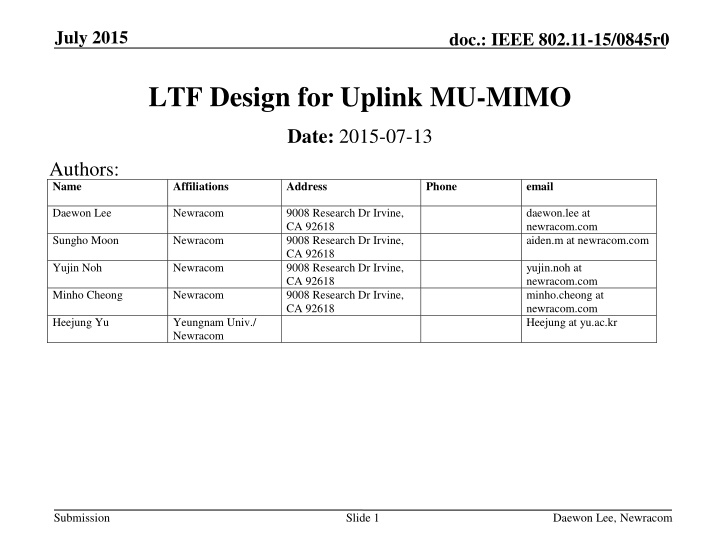
LTF Design for Uplink MU-MIMO IEEE 802.11-15/0845r0
Explore the LTF design proposal for Uplink MU-MIMO in IEEE 802.11-15/0845r0, addressing issues with orthogonal code masking and non-orthogonality of P matrix masking. The research delves into cross-correlation between LTF spatial streams and residual frequency/phase offset compensation using P matrix masked LTF symbols.
Download Presentation

Please find below an Image/Link to download the presentation.
The content on the website is provided AS IS for your information and personal use only. It may not be sold, licensed, or shared on other websites without obtaining consent from the author. If you encounter any issues during the download, it is possible that the publisher has removed the file from their server.
You are allowed to download the files provided on this website for personal or commercial use, subject to the condition that they are used lawfully. All files are the property of their respective owners.
The content on the website is provided AS IS for your information and personal use only. It may not be sold, licensed, or shared on other websites without obtaining consent from the author.
E N D
Presentation Transcript
July 2015 doc.: IEEE 802.11-15/0845r0 LTF Design for Uplink MU-MIMO Date: 2015-07-13 Authors: Name Affiliations Address Phone email Daewon Lee Newracom 9008 Research Dr Irvine, CA 92618 9008 Research Dr Irvine, CA 92618 9008 Research Dr Irvine, CA 92618 9008 Research Dr Irvine, CA 92618 daewon.lee at newracom.com aiden.m at newracom.com Sungho Moon Newracom Yujin Noh Newracom yujin.noh at newracom.com minho.cheong at newracom.com Heejung at yu.ac.kr Minho Cheong Newracom Heejung Yu Yeungnam Univ./ Newracom Submission Slide 1 Daewon Lee, Newracom
July 2015 doc.: IEEE 802.11-15/0845r0 LTF Sequence for Uplink MU-MIMO LTF Sequence masking with orthogonal codes was proposed for Uplink MU-MIMO operation [1]. The idea is to allow full channel estimation within a symbol to allow phase/frequency offset tracking. There are two issues with the proposal 1. Orthogonal code masking does not create orthogonal codes due to CSD application in different spatial streams. May require complex receivers for tracking frequency/phase 2. Code masking to the entire LTF sequence results in very high PAPR sequence. Submission Slide 2 Daewon Lee, Newracom
July 2015 doc.: IEEE 802.11-15/0845r0 Non-Orthogonality of P matrix Masking [ 1 1 1 1 1 1 1 1 ] CSD for SS#1 x HE LTF Sequence 1 [ 1 -1 1 1 ][ 1 -1 1 1 ] Row 1 of P matrix x L6 L1 L2 L3 L4 L5 L7 L8 L1 L2 L3 L4 L5 L6 L7 L8 [ 1 ej2 ej2 2 ej2 3 ej2 4 ej2 5 ej2 6 ej2 7 ] CSD for SS#2 NOT ORTHOGONAL x [ 1 1 -1 1 ][ 1 1 -1 1 ] Row 2 of P matrix x L1 L2 L3 L4 L5 L6 L7 L8 - 2L3 3L4 4L5 5L6 - 6L7 7L8 L1 L2 HE LTF Sequence 2 Submission Slide 3 Daewon Lee, Newracom
July 2015 doc.: IEEE 802.11-15/0845r0 Cross Correlation between LTF Spatial Streams To quantify the non-orthogonality between different LTF spatial streams, we have computed cross correlation between them. When spatial stream are completely orthogonal cross correlation terms would be zero. SS #1 SS #2 SS #3 SS #4 SS #5 SS #6 SS #7 SS #8 SS #1 0.002406 0.049069 0.29361 0.343407 0.000507 0.000301 0.033816 SS #2 0.098141 0.049069 2.31E-07 0.245362 0.00542 0.003688 SS #3 0.002406 0.000678 0.01219 0.09817 0.000307 SS #4 0.003764 7.53E-05 0.000231 0.147246 SS #5 0.001354 0.061323 0.196079 SS #6 0.269276 0.024541 SS #7 0.00634 SS #8 Not all LTF spatial streams are equal, some stream pair have worse interference between each other than other stream pairs. Submission Slide 4 Daewon Lee, Newracom
July 2015 doc.: IEEE 802.11-15/0845r0 Residual Frequency/Phase Offset Compensation with P matrix masked LTF symbols Received LTF symbols (freq-domain) Nss x 242 perform de-spreading per stream K de-spreaded tones used for residual frequency/phase offset D Nss x K Nss x K fo & per STA estimate residual frequency/phase offset Note: We have performed tests with various K. Obviously high K values means higher complexity at the AP receiver. (The chosen tones were evenly spaced across frequency for diversity effects) Nss x 242 Compensated LTF symbols for time domain de-spreading processing Submission Slide 5 Daewon Lee, Newracom
July 2015 doc.: IEEE 802.11-15/0845r0 P-Matrix De-spreading Freq. LTF sequence w/ CSD L1 ej L2 ej2 -L3 ej3 L5 ej5 L6 ej6 -L7 ej7 L4 ej4 L8 ej8 L9 ej9 L10 ej10 -L11 ej11 x x L11* e-j11 L1* e-j L2* e-j2 -L3* e-j3 L10* e-j10 L5* e-j5 L4* e-j4 In total M number of potential channel coefficient estimates from de-spreading h1 h2 h10 Selectively compute (sub-sample) h10 h6 h2 Total of K number of channel coefficient estimates for frequency/phase tracking Submission Slide 6 Daewon Lee, Newracom
July 2015 doc.: IEEE 802.11-15/0845r0 Simulation Setup Simulation Assumption BW: 20MHz Channel Model: TGac Channel D Configuration: 4 Rx AP with FOUR of 1 Tx STA 8 Rx AP with SIX of 1 Tx STA Transmit timing spread among users: spread uniformly within 0us, 0.5us, and 1us Identical SNR among STAs MCS 6, Payload Size 1000 Bytes IPN: -41dBc (both at Tx and Rx) Real frequency/phase offset tracking K de-spread channel coefficients in frequency domain was used in tracking de-spread channel coefficients in time domain (after frequency/phase compensation) used in data symbol equalization Real channel estimation To compare the effect of non-orthogonality, we have also compared with applying block CSD (i.e. phase is rotated every 8 tones) [see APPENDIX] Slide 7 Submission Daewon Lee, Newracom
July 2015 doc.: IEEE 802.11-15/0845r0 Performance with LTF P matrix masking (1/5) 4 Rx AP 1Tx, 4 STA w/ 1 SS 0us transmit time spread among STAs In order to combat non-orthogonality of the P matrix with CSD, residual frequency/phase offset compensation MUST be performed with MANY tones We can see that if P matrix is perfectly orthogonal freq./phase offset tracking works even with 4 values (i.e. tones) Submission Slide 8 Daewon Lee, Newracom
July 2015 doc.: IEEE 802.11-15/0845r0 Performance with LTF P matrix masking (2/5) 4 Rx AP 1Tx, 4 STA w/ 1 SS 0.5us transmit time spread among STAs Similar trend can be observed with transmit time dispersion among STAs Submission Slide 9 Daewon Lee, Newracom
July 2015 doc.: IEEE 802.11-15/0845r0 Performance with LTF P matrix masking (3/5) 4 Rx AP 1Tx, 4 STA w/ 1 SS 1us transmit time spread among STAs Similar trend can be observed with transmit time dispersion among STAs Submission Slide 10 Daewon Lee, Newracom
July 2015 doc.: IEEE 802.11-15/0845r0 Performance with LTF P matrix masking (4/5) 8 Rx AP 1Tx, 6 STA w/ 1 SS 0us transmit time spread among STAs Non-orthogonality issue impacts performance more critically when more spatial streams are used. Submission Slide 11 Daewon Lee, Newracom
July 2015 doc.: IEEE 802.11-15/0845r0 Performance with LTF P matrix masking (5/5) 8 Rx AP 1Tx, 6 STA w/ 1 SS 0.5us transmit time spread among STAs Similar trend Submission Slide 12 Daewon Lee, Newracom
July 2015 doc.: IEEE 802.11-15/0845r0 PAPR issue with P matrix masking PAPR effects implementation complexity/cost of the transmit RF components. PAPR of the LTF symbols used for channel estimation should be sufficiently lower than data PAPR. LTF sequences are typically designed such that low PAPR property is met. Multiplication of P matrix across the ENTIRE transmitted tones, completely destroys nice PAPR property of LTF sequences. Submission Slide 13 Daewon Lee, Newracom
July 2015 doc.: IEEE 802.11-15/0845r0 PAPR of LTF Symbols with P matrix Masking Observation: P matrix masked LTF can have up to 8.8 dB PAPR There is 80% probability that data OFDM symbols have less than 8.8dB PAPR. P matrix masked LTF OFDM symbols have higher mean/median PAPR than data OFDM symbols Submission Slide 14 Daewon Lee, Newracom
July 2015 doc.: IEEE 802.11-15/0845r0 Conclusion We have identified significant issues with LTF masked with P matrix for Uplink MU-MIMO as proposed in [1]. The proposal creates several implementation challenges and requires highly complex receiver implementation. We urge that further study to be performed on LTF design for uplink MU-MIMO as it has critical impact to performance and implementation. Submission Slide 15 Daewon Lee, Newracom
July 2015 doc.: IEEE 802.11-15/0845r0 Strawpoll Do you agree that more analysis of implementation complexity and performance on various scenarios is needed for uplink MU-MIMO LTF design? Y/N/A: Submission Slide 16 Daewon Lee, Newracom
July 2015 doc.: IEEE 802.11-15/0845r0 References [1] IEEE802.11-15/0602r1, HE-LTF Sequence for UL MU-MIMO, May 2015. Submission Slide 17 Daewon Lee, Newracom
July 2015 doc.: IEEE 802.11-15/0845r0 Appendix: Example of Block CSD vs Regular CSD Regular CSD (every tone) Block CSD (every 4 tones) Phase of CSD changed every few tones Phase of CSD changed every tone [ej2 ej2 ej2 ej2 ej2 5 ej2 5 ej2 5 ej2 5 ] [ 1 ej2 ej2 2 ej2 3 ej2 4 ej2 5 ej2 6 ej2 7 ] CSD for SS #m x x [ 1 1 -1 1 ][ 1 1 -1 1 ] x [ 1 1 -1 1 ][ 1 1 -1 1 ] x Row m of P matrix L1 L2 L3 L4 L5 L6 L7 L8 L1 L2 L3 L4 L5 L6 L7 L8 LTF sequence Final Output Sequence Final Output Sequence Orthogonal Not Orthogonal Submission Slide 18 Daewon Lee, Newracom

